Tack & Farm
Our Tack & Farm section features an Apparel section to find both practical and fashionable riding attire. If you ride English & Western or Race, many sources are available in the Tack section.
Building a barn? Need an architect for your equine dream home? Find one in Barns & Stalls.
Have a hungry horse? Of course you do! Find a place to buy your feed and tuck your horse in at night in the Bedding & Feed section. Looking for a place to keep your horse? You can find it in the Horse Boarding section. Keep your horse happy and beautiful with resources in our Grooming section.
Traveling? Find a Shipping company or Horse Sitting service if your horse is staying home!
Running and maintaining a farm or stable is a continuous effort, and to help find products or tools you need, please see our Equipment, Fencing and Management Tools sections.
Seeking Services? Find financial and tax expertise in our Accounting section. Companies who will help protect your investment are found in the Insurance section. For those who want legal advice about purchasing, liability, and other issues, please look at the Equine Law section to find an expert. Build and promote your business with teams from Marketing / Videography / Web Design.
Do we need to add more? Please use the useful feedback link and let us know!
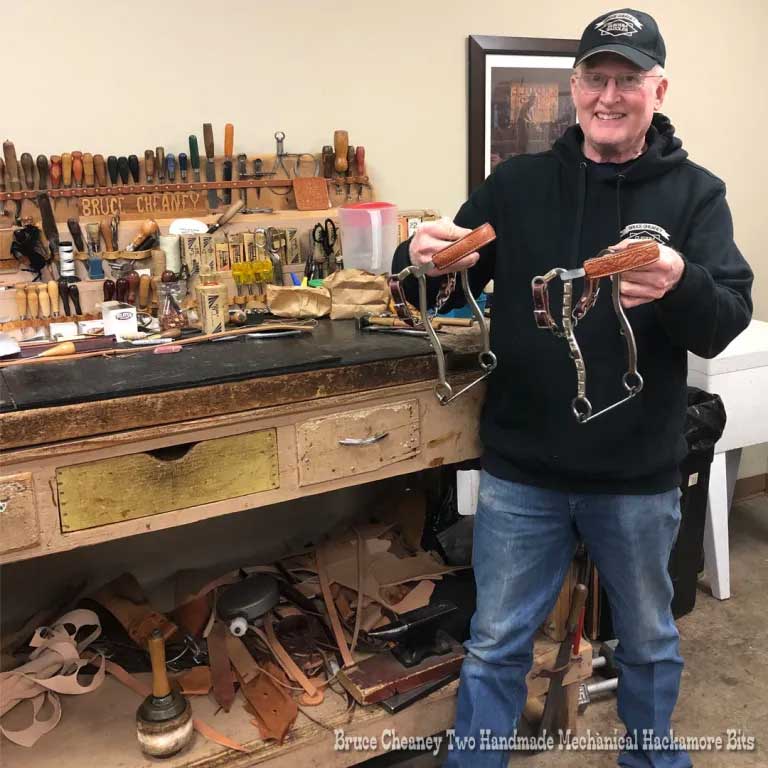
Let’s jump back in time about 150 years. A great fire has turned Chicago into a city of ashes. The James Gang had robbed its first train robbery. Cowboys are driving thousands of cattle up from Texas to the railheads in Kansas. And Charles D. Cheaney has opened up his saddle shop in Gainesville, Texas.
Five generations later, Bruce Cheaney, 71, is making saddles with the same attention to detail that his leather stitching ancestors did. Today, Bruce Cheaney is doing much more than making great saddles and leather work. He is introducing new generations of craftsmen to the wonders of leather work. Don’t believe me? Try tuning into https://www.youtube.com/cheaneysaddles, Bruce Cheaney’s YouTube channel, which has more than seventy-eight thousand followers. Even if you know nothing about the craft, Bruce will inspire you to pick up a piece of leather and start to work.
Why is his channel so popular?
“Leather working is a good way to express yourself through your work,” Bruce says with typical humility. It’s more than the appeal of leather work that makes Bruce Cheaney’s online and real-time work so popular. It’s the grace of his manner, his soft North Texas accent, and the obvious skill that he brings to his craft.
“Hello. Bruce Cheaney here in the saddle shop in Gainesville, Texas,” Bruce says to introduce one of his YouTube tutorials in his soft North Texas drawl. Bruce is all work but has the easy manner of your neighbor. He’s not Mr. Rogers. He’s not Roy Rogers. He’s the real deal.
“My most popular products are custom-made saddles and handmade mechanical hackamore bits with a flat leather nose band.” Yup, Bruce is best known for his saddles and tack, just like the Cheaney’s that have worked in Gainesville for a century and a half.
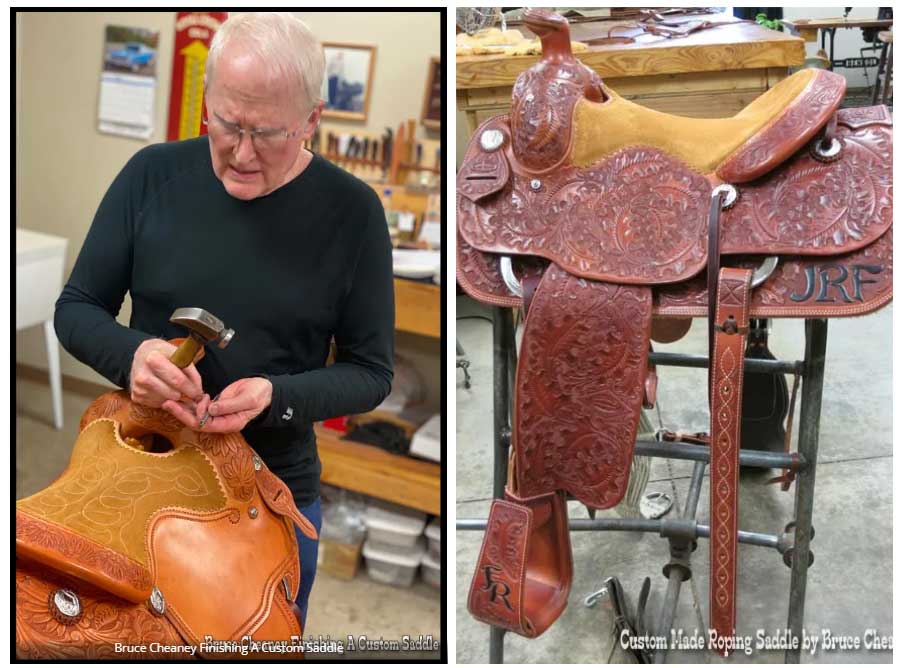
The tradition of saddle making goes way, way back, about 6,000 years back, to the time when horses were first domesticated. People have made saddles for camels, oxen, and even an ostrich or two, but making saddles for horses has always been the core of the saddle making business.
Eurasian nomads, Alexander the Great, Chinese Emperors, Roman Legionaries, the knights of the Middle Ages all used saddles, not just as tools to improve their horsemanship but also as symbols of power and taste. The modern western style saddle with a solid saddle tree, pommel, and stirrups has been around for hundreds of years. The western style saddle was first introduced into what is now the United States by Spanish conquistadors, who raised cattle and fought bulls on what we would recognize as western saddles.
A saddle is not as simple as it may appear. Saddles come in a wide variety of styles each designed for a specific equestrian discipline. The most important thing about a saddle is that it must be comfortable for both rider and horse. Making that happen is a challenge. A rule of thumb is that the saddle must not do any damage to the horse’s withers, and it must give a rider the proper balance to perform on horseback, whether he or she is roping, cutting, or trail riding.
“I use only the best saddle trees made by maker’s who know how to make a saddle tree that fits,” Bruce says. “I also have specs for saddle trees that have worked for me for many years.”
Bruce makes his saddles by hand featuring vegetable-tanned leather hand-carved and tooled in oak leaf and acorn pattern. He builds a saddle seat with loop-through stirrup leathers, and he makes the fenders, or pieces of leather on the side, with roughout leather to enhance the rider’s grip.
“Custom roping saddles are my favorite saddles to make,” Bruce says.
“I love to make heavy duty roping saddles that perform well and are comfortable for both horse and rider.”
Bruce is also well known for his mechanical hackamores. Decades ago, cutting horse champion Matlock Rose from Gainesville asked Bruce to make him a hackamore bit with long leverage so he wouldn’t have to hurt his horse’s mouth. Matlock Rose liked the tack so much, he became a regular visitor at the Cheaney’s shop.
Building a hackamore requires working with metal, a skill that Bruce has mastered in addition to his leather work. According to Bruce, “Metal working requires a separate workshop because of the grinding dust and equipment such as a Tig welder and heavy-duty belt sanders.”
Bruce’s customers include ranchers, working cowboys and well-known horsemen including J.D Yates, Frank G. Merrill, and the late Sam Rose and Robbie Schroeder.
Many of Bruce’s clients have become life-long customers. How has Bruce managed to develop such a loyal clientele? According to Bruce, “They just like what I make.”
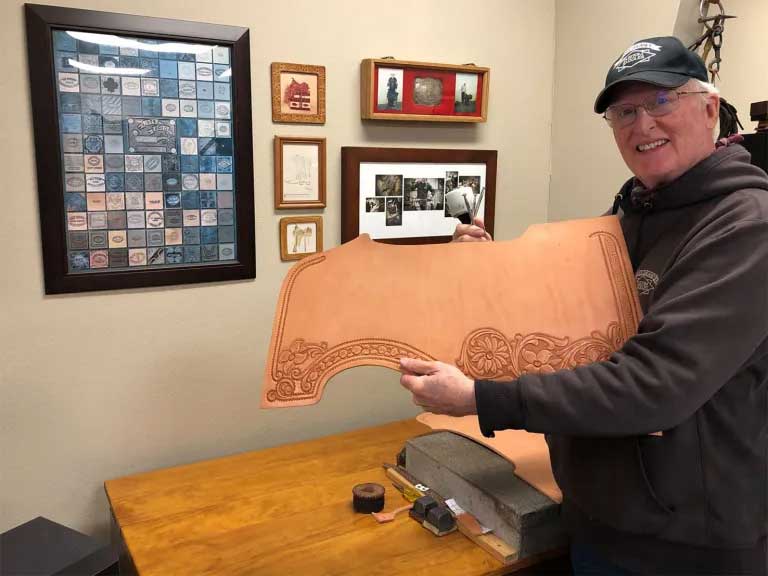
Bruce also enjoys making belts, sheaths for knives, and even coasters. “The most challenging project I have ever worked on was a longhorn skull mount that I tooled and carved and antiqued. I also had to make the mounting brackets for it.”
No matter what his clients want, Bruce is up to the challenge. “A friend of mine asked me to make him a pair of hunting knives and sheaths. I made the handle with deer stag from the Stark Ranch. I added a concho bead on the end of the handle with the ranch brand. It took me two weeks.” Craftmanship takes time, but his clients appreciate Bruce’s attention to detail which is part of the Cheaney heritage.
Julie Goodnight will demonstrate on how to properly adjust the back or rear cinch and the breast collar. This is a educational and safety video brought to you by the Certified Horsemanship Association (CHA).
Read more: Breast Collar and Back Cinch Adjustment with Julie Goodnight (6:46)

By Nick Pernokas
It was a good day for a fleece lined jacket, or even a quilted down coat, if you had one. The southwestern Oklahoma wind blew cold on that Christmas Eve of 1953. The Christmas party’s host was a roper, so naturally many of his guests were cowboys as well. Famed Oklahoma roper, Dee Burk, was in attendance and he’d brought his brother-in-law, Amye Gamblin, with him. Amye was also a good roper and horse trainer from California. Dee’s talk about the good job that Amye had out west was only reinforced by the new Lincoln parked outside with California plates.
Dee introduced Amye to a young man who liked to rope calves. Amye liked him instantly and invited him out to his car. It was a dark night, but Amye opened his trunk by the light of a flashlight and there, sitting on its side, was a Chuck Sheppard saddle, which had been built by Rowell Saddle Company in California.
“Here’s the best tree I ever rode,” Amye said to Howard Council. “You should try to get some of them.”
“I liked the looks of it,” remembered Howard, almost 50 years later. “It had some swell to it, but it still had just a two-and-a-half-inch cantle. What I liked about the original Chuck Sheppard was that it had some swell, like an Association but lower. I guess that’s what Chuck liked since he was a bronc rider. Later they started calling a lot of saddles ‘Chuck Sheppard’s’ and they weren’t anything like that.”
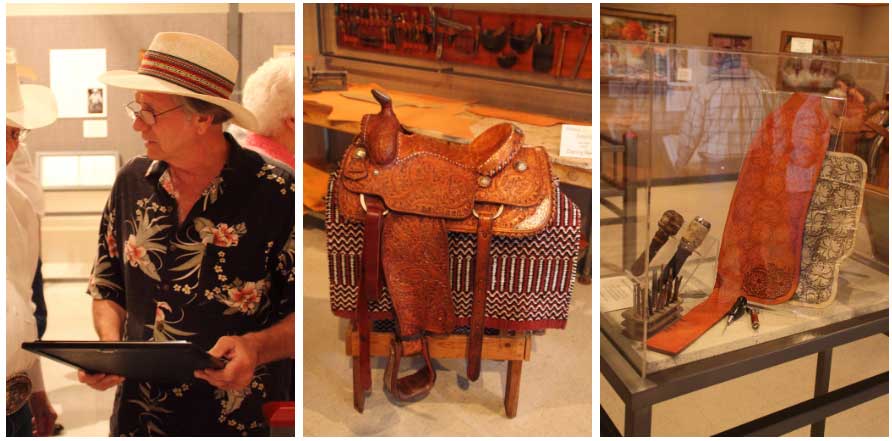
This Christmas Eve encounter would turn out to be a watershed moment for the calf roping industry, but Howard Council’s story begins a lot earlier.
Howard was born in Durant, Oklahoma, in 1926. When he was five, his family moved to Lawton, Oklahoma, and that would be where he remained for the rest of his life. When Howard was 13 or 14, his family bought a house outside of town. Even though Howard’s family had never been involved with horses, Howard had always wanted one. Then, he bought a horse and built a pen for it.
At the time, southwestern Oklahoma was home to a lot of cowboys who were competing in the sport of calf roping. As a teenager, Howard became interested in calf roping and started learning from some of the local ropers. He fell in love with the sport, but his smaller stature hindered him at a time when the calves roped at rodeos were fairly large.
In 1944, Howard became interested in working with leather. He had wanted a belt with his name on it, which was a big deal at the time. A man came to town and ran an ad in the paper saying that he made belts. The craftsman was just passing through, but he rented a house for a while and set up shop in it. He made Howard a belt and Howard was fascinated with the tooling process. He asked the man where he could get some stamping tools and the man gave him an address of a company in Tulsa. Howard didn’t know what tools to order, but he looked at his new belt and figured out which ones would apply. There weren’t any books available to Howard, so he taught himself how to tool leather through trial and error with his belt as a model.
“I just taught myself to carve leather,” said Howard.
At the time, Howard’s day job was driving a wholesale magazine truck.
“I started making belts and I was roping calves, but I couldn’t beat anybody. It was just a hobby.”
Howard quit roping in 1947, and married Genevieve Thomas in 1949. At night he made belts for many of his roping friends. Genevieve’s uncle suggested that he should open a leather shop. At first Howard was skeptical, but soon his orders were piling up.
“One thing about the roping was that I got to know a lot of ropers and even got to working on some saddles for them.”
The more Howard thought about it, the more he liked the idea of his own shop.
“I was so damn dumb I didn’t know what I was doing. There we were, newly married, me a nobody and I hung my shingle out in the corner of my wife’s uncle’s upholstery shop, and thought I’d automatically start making a living. Boy, it was pretty rough, just making belts, billfolds, whatever anybody wanted.”
One day, a friend that had roped with Howard asked him if he could build a saddle. Howard told him that he’d torn a lot of them apart to repair them, so he thought he could. The cowboy offered to pay for the materials if Howard wanted to experiment. Howard began to build the saddle in his spare time on a Fred Lowery saddle tree. It was a style that many ropers were using then. It had a two-inch cantle, no swell and a Mexican horn.
“That’s what they all rode back then. Well, it worked and it was a full-carved saddle of all things. I should have made it plain since I wasn’t getting paid for it.”
Soon, someone else wanted one built and while Howard wasn’t making a living from it, he was getting a lot of experience.
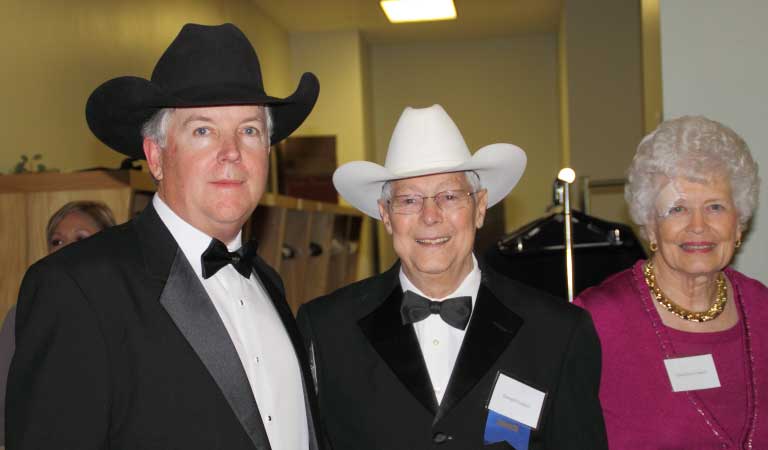
By the time of the 1953 Christmas party, Howard had the fundamentals of saddle construction mastered. Dee and Amye had handed him a blueprint for the future of roping saddles. In dusty little arenas around Oklahoma, ropers were figuring out new techniques for better trained rope horses and faster runs. They were ready for a saddle built exclusively for the sport. Howard bought two Chuck Sheppard saddle trees from Rowell. One was used to retree a customer’s saddle and the other was made up as a rough out saddle for another customer. The saddle cost $135 and it fit a horse well. Ropers were becoming more aware of how their horses worked with a better fitting saddle and word of Howard’s saddles spread. The ball was rolling and Howard built a lot of saddles on the old CS tree. Howard bought just enough leather for one saddle at a time from a jobber.
“I look back now and I don’t know how we were making a living at it.”
Howard was busy and working all night long when he had to. He tried to make the best saddle he could and still get them turned out. He was able to turn out one saddle a week. Howard started to experiment with other styles of saddle trees. He saw a Toots Mansfield roping saddle that Porter’s Saddlery in Phoenix had made and really liked it. P.Q. Ritter from Portland, Oregon, made the trees for Porters.
“The original was designed by Toots and it wasn’t like the ones you see now. It was leveler on the top and had more swell showing. I try to change mine more like the originals. Toots was my hero so I did a few things like the Porters.”
Howard used an inskirt rigging that was similar to Porter’s on many of his saddles. He felt that they were just as strong as a conventional rigging.
“If you look at these pictures of ropers in my saddles, you can see exactly what I’m trying to do. I want their feet under them, never behind; they don’t have to lean forward to get against the swell. Their feet are locked in under them.”
Howard found out early in his career that one saddle wouldn’t fit every horse. He really liked the original CS Rowell bars, but thought that later tree makers began rounding the bars too much on the bottom. Around 1960, Howard began flattening the bottoms of the bars himself. He wasn’t really doing it for an individual fit, but rather to make them flatter like the old Rowell trees. Howard also began experimenting with fiberglass then. The saddle trees were single covered rawhide and he would recover the bottoms of the bars with fiberglass after he worked on them.
Around 1980, Howard shaped the bars on a tree to fit Barry Burk’s horse, Bandit. Immediately, he was flooded with ropers wanting saddles custom fitted to their horse’s backs.
True ‘custom’ saddles are customized in the tree (structural chassis) of the saddle. Consider these criteria for achieving optimal fit to the rider.
Besides being comfortable for the rider, the saddle seat has a huge influence on the ability of the rider to sit properly and in balance, to be able to give good aids to the horse, and to become one with the horse so that the exercises are harmonious.
The front of the saddle should not be uncomfortable for the rider at either the pubic symphysis or in the private parts. This can be easily tested when trying saddles out for size in the shop, or on the horse. Test the saddle wearing jeans (which have lots of seaming in the crotch area). Sit on the saddle and lean far forward and far back. You should be able to feel your jean seams only when you are out of the natural shoulder-hip-heel plumb line position. If you can feel the seams in the full range of this motion exercise, the saddle is not for you. Ask a friend to tell you when you are actually sitting straight.
Read more: How is a Saddle Custom Made for the Rider (5:21) - Saddlefit 4 Life
- The Extraordinary Talent of Bill Knight
- Saddle Fit for Women's Anatomy (2:47) - Saddlefit 4 Life
- Davis Reynolds: Full-Service Saddlemaker
- Saddle Fit Basics: Protecting Your Horse From Ill Fitting Tack (16:01)
- Sizing Up Your Horse Barn and Farm Entranceways for Safety and Security
- The Delight of Keeping Donkeys and How to Care for Them
- What’s The Pitch on Horse Barn Roofs
- Good Reasons Not to Brave the Weather When It Comes to Horse Care
- Five Western Saddle Q&As
- Horses and Vehicles – The Practicalities of Mixing Horsepower Housing
































